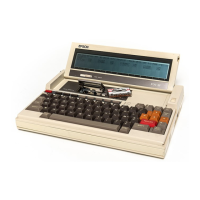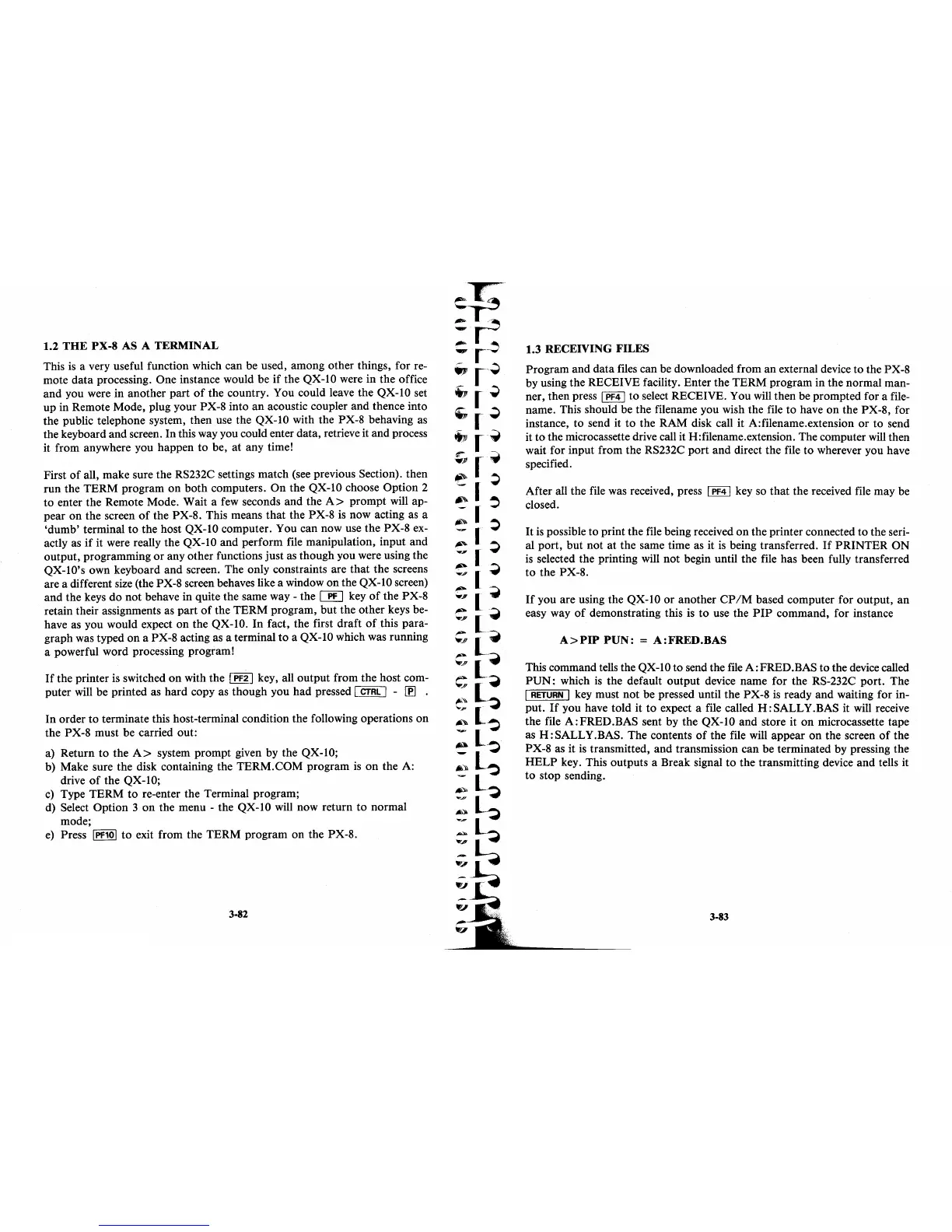1.2
THE
PX-8 AS A TERMINAL
This
is
a very useful function which can be used, among other things, for re-
mote data processing. One instance would be
if
the QX-lO were in the office
and you were in another part
of
the country. You could leave the QX-lO set
up in Remote Mode, plug your PX-8 into
an
acoustic coupler and thence into
the public telephone system, then use the QX-lO with the PX-8 behaving as
the keyboard and screen. In this way you could enter data, retrieve it and process
it from anywhere you happen to be, at any time!
First
of
all, make sure the RS232C settings match (see previous Section). then
run
the TERM program
on
both computers.
On
the QX-IO choose Option 2
to enter the Remote Mode. Wait a few seconds and the
A>
prompt will ap-
pear on the screen
of
the PX-8. This means
that
the PX-8
is
now acting as a
'dumb'
terminal to the host QX-lO computer. You can now use the PX-8 ex-
actly as
if
it were really the QX-IO and perform file manipulation, input and
output, programming
or
any other functions just as though you were using the
QX-IO's own keyboard and screen. The only constraints are
that
the screens
are a different
size
(the PX-8 screen behaves like a window on the QX-lO screen)
and the keys do
not
behave in quite the same way - the
00
key
of
the PX-8
retain their assignments as
part
of
the TERM program,
but
the other keys be-
have as you would expect
on
the QX-IO.
In
fact, the first draft
of
this para-
graph was typed on a PX-8 acting as a terminal
to
a QX-IO which was running
a powerful word processing program!
If
the printer
is
switched
on
with the I PF21 key, all output from the host com-
puter will be printed as hard copy as though you had pressed
@i!!J
-
~
.
In
order
to
terminate this host-terminal condition the following operations
on
the PX-8 must be carried out:
a) Return
to
the
A>
system prompt given by the QX-lO;
b) Make sure the disk containing the TERM.COM program
is
on
the A:
drive
of
the QX-lO;
c)
Type TERM
to
re-enter the Terminal program;
d) Select Option 3
on
the menu - the QX-lO will now return
to
normal
mode;
e) Press
IPF101
to
exit from the TERM program
on
the PX-8.
3-82
1.3 RECEIVING FILES
Program and data files can be downloaded from an external device to the PX-8
by using the RECEIVE facility. Enter the TERM program in the normal man-
ner, then press
I PF4 I to select RECEIVE. You will then be prompted for a file-
name. This should be the filename you wish the file to have on the PX-8, for
instance, to send it
to
the RAM disk call it A:filename.extension
or
to send
it to the microcassette drive call it H:filename.extension. The computer
will
then
wait for input from the RS232C port and direct the file to wherever you have
specified.
After all the file was received, press
I
PF41
key so
that
the received file may be
closed.
It
is
possible to print the file being received
on
the printer connected to the seri-
al port,
but
not at the same time as it
is
being transferred.
If
PRINTER ON
is
selected the printing will not begin until the file has been fully transferred
to
the PX-S.
If
you are using the QX-lO or another
CP/M
based computer for output, an
easy way
of
demonstrating this
is
to
use the
PIP
command, for instance
A>PIP
PUN:
=
A:FRED.BAS
This command tells the QX-lO to send the
file
A:
FRED.
BAS
to the device called
PUN:
which
is
the default output device name for the RS-232C port. The
I RETURN I key must
not
be pressed until the PX-8
is
ready and waiting for in-
put.
If
you have told it
to
expect a file called
H:
SALLY .BAS it will receive
the file
A:FRED.BAS
sent by the QX-lO and store it
on
microcassette tape
as H:SALLY.BAS. The contents
of
the file will appear
on
the screen
of
the
PX-S as it
is
transmitted, and transmission can be terminated by pressing the
HELP
key. This outputs a Break signal
to
the transmitting device
and
tells it
to
stop sending.
3-83

